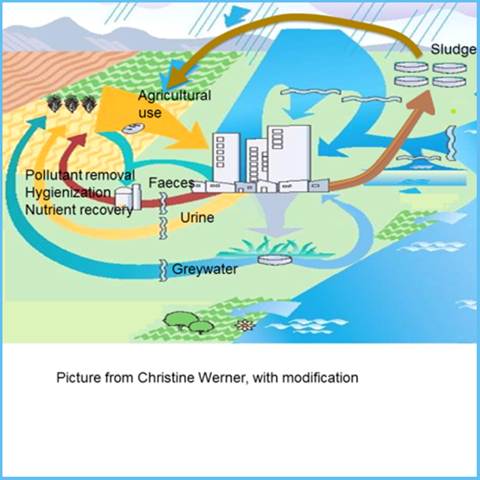Wastewater

We are developing robust systems for on-site treatment of various wastewater fractions: grey-water (used water from kitchen, showers and laundry), black-water (mixture of urine, faeces and flush water), mixed effluent (grey-water and black-water) and sewage sludge. Types of pollutants which need to be removed from wastewater during the treatment depend on the end use and the type of recipient of the treated wastewater. Discharge of treated wastewater into streams is common way of disposal.
In this case, removal of easily degradable organic matter, nitrogen, phosphorus, drug residues and wastewater pathogens is important – yet challenging. Most people in the world (4.1 billion) do not have their wastewater treated before discharging it into the environment (Baum et al., 2013). Globally, use of wastewater for irrigation is the most common pathway for reuse of nitrogen and phosphorus as fertiliser. Thus, nitrogen and phosphorus need not be removed from wastewater (which is what a well operating wastewater treatment plant does). Instead, other pollutants e.g pathogens and micro-organic contaminants need to be removed from the wastewater to assure its safe use in terms of human health and environmental impact.
Using organic filters (bark and biochar filters), we test and optimise removal of easily degraded organic matter, phosphorus, nitrogen, pathogens and micro-organics such as pharmaceutical residues and poly- and per- fluorinated alkyl acids (PFAS) (Dalahmeh et al., 2014; Karlsson et al., 2015; Niwagaba et al., 2014). In addition, we work on identification of different sources and flows of micro-pollutants in wastewater so as to suggest upstream and at-source solutions to minimise these pollutants in wastewater flows. Apart from this, we work on assessing performance of engineered solutions to minimise levels of micro-pollutants in wastewater at the end of the pipe. This is intended for small-scale and on-site wastewater systems. Our research is not restricted to lab scale treatment filters; we also work with pilot scale filters which serve single households. Wastewater treatment is necessary locally and globally.
The largest risk when reusing treated wastewater is the spread of pathogens from the wastewater to crops, farmers and consumers. To contribute with knowledge on how to minimise such risk, we evaluate different technical options for wastewater treatments that are to be installed between the wastewater source and the field. The objective of the technologies is to reduce the pathogen load in the irrigation water and hence reduce the risk of infection (Dalahmeh et al., 2016). We model the accumulation of micro organics in the soil after irrigation and fertilisation with sewage products and see how these contaminants may spread through the harvested crops. In addition, we analyse and evaluate the risks with regards to pathogens, organic contaminants in the wastewater, black-water and sewage sludge intended for agriculture application.
Publications
Baum, R., Luh, J., Bartram, J. 2013. Sanitation: A Global Estimate of Sewerage Connections without Treatment and the Resulting Impact on MDG Progress. Environmental Science & Technology, 47, 1994-2000.
Dalahmeh, S.S., Lalander, C., Pell, M., Vinneras, B., Jonsson, H. 2016. Quality of greywater treated in biochar filter and risk assessment of gastroenteritis due to household exposure during maintenance and irrigation. J Appl Microbiol, 121(5), 1427-1443.
Dalahmeh, S.S., Pell, M., Hylander, L.D., Lalander, C., Vinnerås, B., Jönsson, H. 2014. Effects of changing hydraulic and organic loading rates on pollutant reduction in bark, charcoal and sand filters treating greywater. Journal of Environmental Management, 132(0), 338-345.
Karlsson, S.C., Langergraber, G., Pell, M., Dalahmeh, S., Vinneras, B., Jonsson, H. 2015. Simulation and verification of hydraulic properties and organic matter degradation in sand filters for greywater treatment. Water Sci Technol, 71(3), 426-33.
Niwagaba, C.B., Dinno, P., Wamala, I., Dalahmeh, S.S., Lalander, C., Jönsson, H. 2014. Experiences on the implementation of a pilot grey water treatment and reuse based system at a household in the slum of Kyebando-Kisalosalo, Kampala. Journal of Water Reuse and Desalination, 4(4), 294-307.